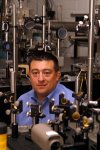laserrod
0
- Joined
- Aug 3, 2007
- Messages
- 342
- Points
- 0
The Texas Petawatt laser reached greater than one petawatt of laser power on Monday morning, March 31, making it the highest powered laser in the world, Todd Ditmire, a physicist at The University of Texas at Austin, said.
The Texas Petawatt is the only operating petawatt laser in the United States.
Ditmire says that when the laser is turned on, it has the power output of more than 2,000 times the output of all power plants in the United States. (A petawatt is one quadrillion watts.) The laser is brighter than sunlight on the surface of the sun, but it only lasts for an instant, a 10th of a trillionth of a second (0.0000000000001 second).
Ditmire and his colleagues at the Texas Center for High-Intensity Laser Science will use the laser to create and study matter at some of the most extreme conditions in the universe, including gases at temperatures greater than those in the sun and solids at pressures of many billions of atmospheres.
This will allow them to explore many astronomical phenomena in miniature. They will create mini-supernovas, tabletop stars and very high-density plasmas that mimic exotic stellar objects known as brown dwarfs.
“We can learn about these large astronomical objects from tiny reactions in the lab because of the similarity of the mathematical equations that describe the events,” said Ditmire, director of the center.
Such a powerful laser will also allow them to study advanced ideas for creating energy by controlled fusion.
Source: University of Texas at Austin
Via: http://www.physorg.com/news126847791.html
The Texas Petawatt is the only operating petawatt laser in the United States.
Ditmire says that when the laser is turned on, it has the power output of more than 2,000 times the output of all power plants in the United States. (A petawatt is one quadrillion watts.) The laser is brighter than sunlight on the surface of the sun, but it only lasts for an instant, a 10th of a trillionth of a second (0.0000000000001 second).
Ditmire and his colleagues at the Texas Center for High-Intensity Laser Science will use the laser to create and study matter at some of the most extreme conditions in the universe, including gases at temperatures greater than those in the sun and solids at pressures of many billions of atmospheres.
This will allow them to explore many astronomical phenomena in miniature. They will create mini-supernovas, tabletop stars and very high-density plasmas that mimic exotic stellar objects known as brown dwarfs.
“We can learn about these large astronomical objects from tiny reactions in the lab because of the similarity of the mathematical equations that describe the events,” said Ditmire, director of the center.
Such a powerful laser will also allow them to study advanced ideas for creating energy by controlled fusion.
Source: University of Texas at Austin
Via: http://www.physorg.com/news126847791.html





